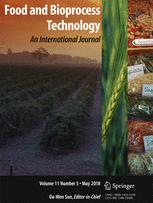Ver ítem
- xmlui.general.dspace_homeCentros e Institutos de InvestigaciónCIA. Centro de Investigaciones de AgroindustriaInstituto de Tecnología de AlimentosArtículos científicosxmlui.ArtifactBrowser.ItemViewer.trail
- Inicio
- Centros e Institutos de Investigación
- CIA. Centro de Investigaciones de Agroindustria
- Instituto de Tecnología de Alimentos
- Artículos científicos
- Ver ítem
Calcium Addition, pH and High Hydrostatic Pressure Effects on Soybean Protein Isolates—Part 2: Emulsifying Properties
Resumen
Soybean protein isolates (SPI) represent an important source of proteins that are used to prepare oil-in-water (o/w) emulsions. The influence of an innovative treatment (high hydrostatic pressure, HHP) combined with calcium addition at different pH levels and protein concentrations on the formation and stability of o/w SPI emulsions was evaluated in this work. When applied separately, calcium addition or HHP treatment produced different effect at pHs 5.9
[ver mas...]
Soybean protein isolates (SPI) represent an important source of proteins that are used to prepare oil-in-water (o/w) emulsions. The influence of an innovative treatment (high hydrostatic pressure, HHP) combined with calcium addition at different pH levels and protein concentrations on the formation and stability of o/w SPI emulsions was evaluated in this work. When applied separately, calcium addition or HHP treatment produced different effect at pHs 5.9 and 7.0. Calcium addition led to stable emulsions with decreased flocculation index (FI) at pH 5.9 and low protein concentration (5 g L−1), whereas at pH 7.0, this effect was observed at high protein concentration (10 g L−1). In these conditions, calcium would favor the arrival of big aggregates to interface, which would be modified and adsorbed during homogenization. Treatment with HHP decreased FI and stabilized emulsions during storage at pH 7.0 (but not at pH 5.9) when prepared from 10 g L−1 protein dispersions. In these conditions, protein unfolding due to HHP-induced denaturation, and high ζ-potential would be responsible for emulsion improvement. Combination of calcium addition and HHP treatment impaired both formation and stabilization abilities of SPI at both pHs. Bridging flocculation was enhanced in these samples while interfacial protein concentration and percentage of adsorbed protein were increased. Thus, soybean proteins that were subjected to combined calcium addition and HHP treatment exhibited a great ability to associate each other, what can be useful to improve other functional properties such as gelation.
[Cerrar]

Autor
Manassero, Carlos Alberto;
Beaumal, Valérie;
Vaudagna, Sergio Ramon;
Speroni, Francisco;
Anton, Marc;
Fuente
Food and Bioprocess Technology 11 (11) : 2079–2093 (November 2018)
Fecha
2018-08
ISSN
1935-5130
1935-5149
1935-5149
Formato
pdf
Tipo de documento
artículo
Palabras Claves
Derechos de acceso
Restringido
 Excepto donde se diga explicitamente, este item se publica bajo la siguiente descripción: Creative Commons Attribution-NonCommercial-ShareAlike 2.5 Unported (CC BY-NC-SA 2.5)
Excepto donde se diga explicitamente, este item se publica bajo la siguiente descripción: Creative Commons Attribution-NonCommercial-ShareAlike 2.5 Unported (CC BY-NC-SA 2.5)

